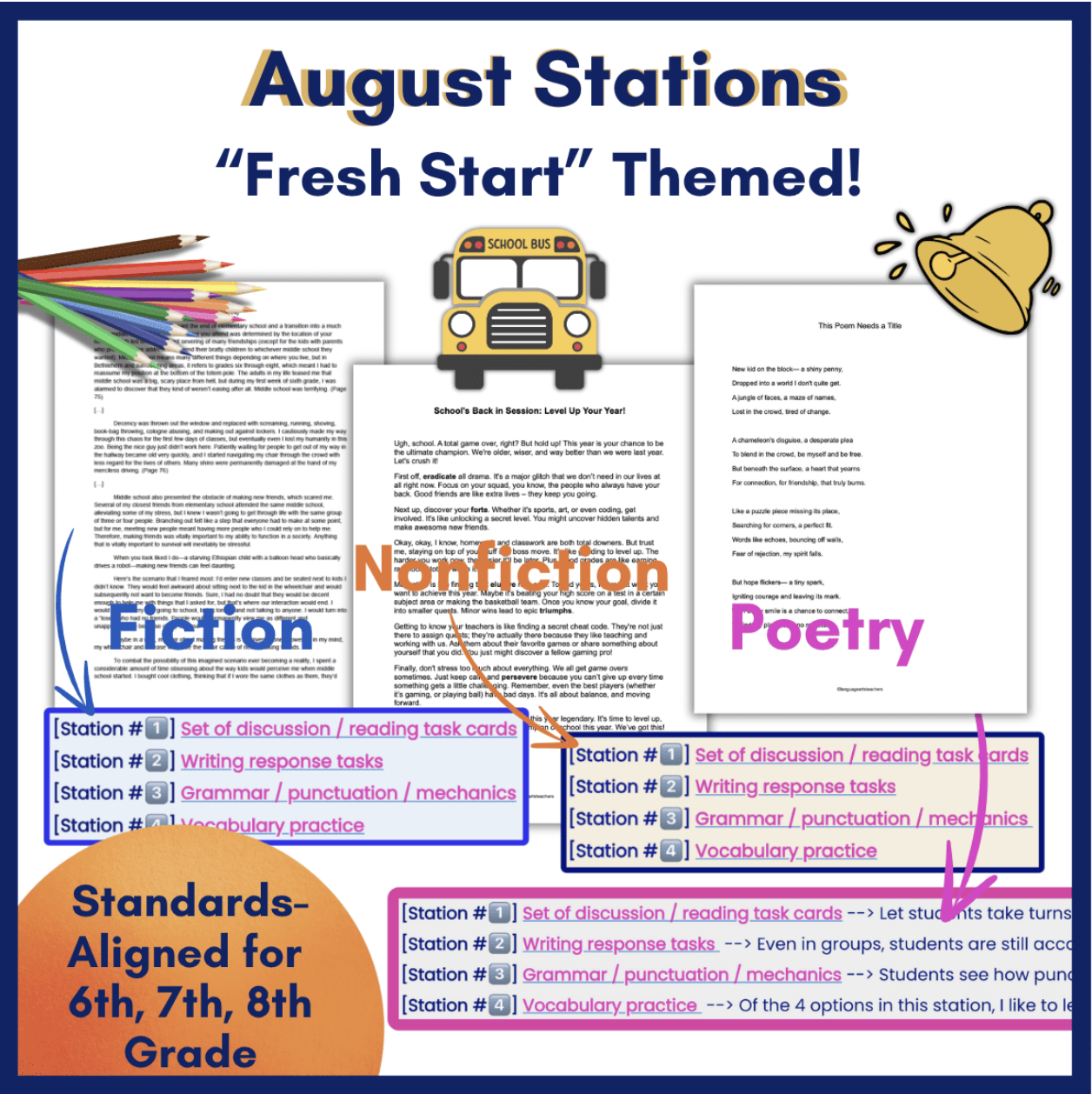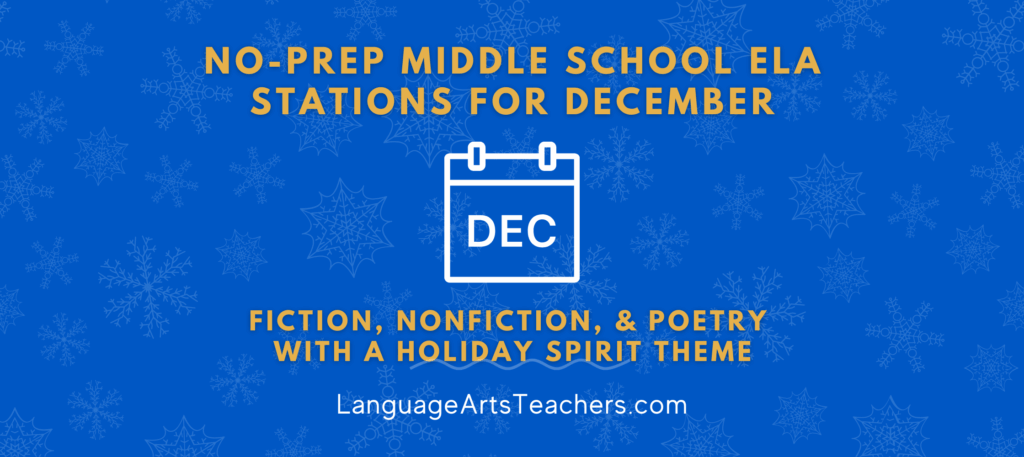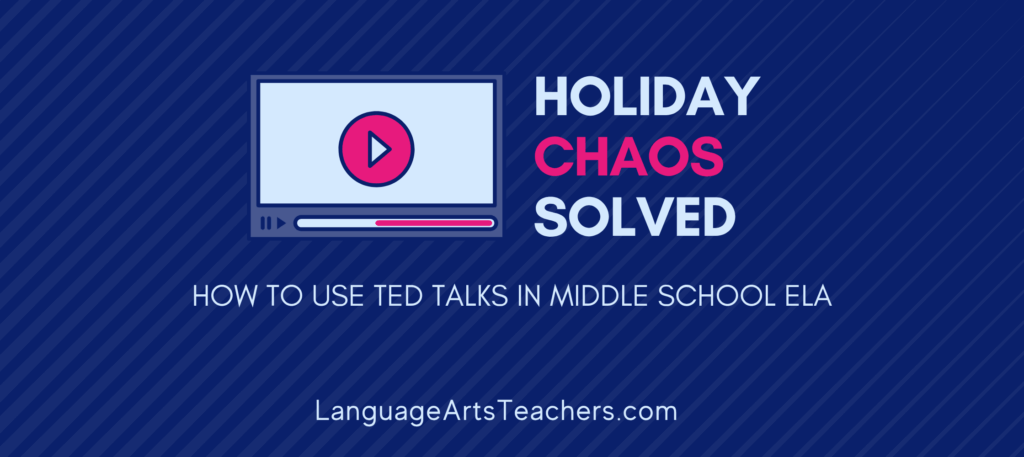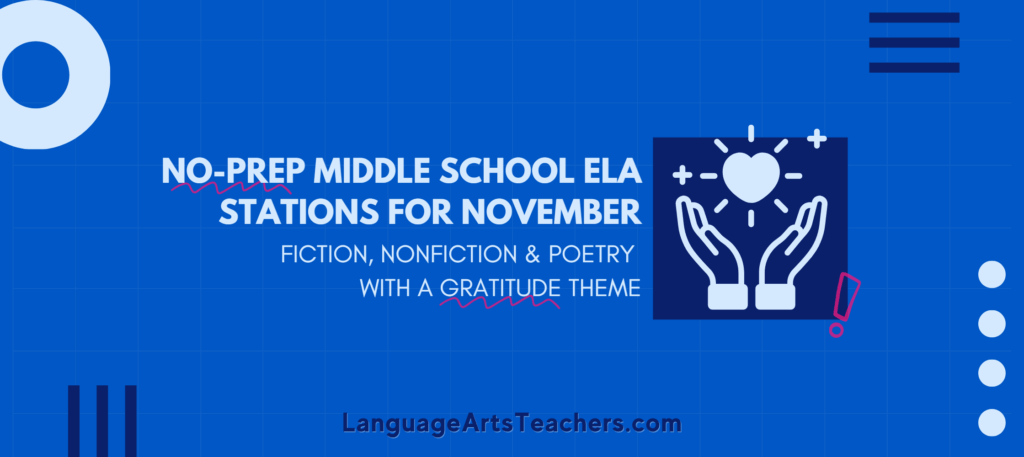The beginning of the school year brings with it that “fresh start – fitting in” vibe. We’ll capitalize on that by bringing in three reading pieces that are thematically tied to that exact topic: A fiction piece, a nonfiction piece, and a poem that helps students see that starting over and fitting in are common elements we all endure as part of our human experience—in real life and in literature.
Setting up and running stations, while engaging for students, can sometimes feel random, like a bunch of “activities” are just being smushed together for the sake of keeping students active and busy.
But when we have a common theme that each reading piece AND each practice builds on—fresh starts and fitting in—then all the reading, writing, grammar, and vocabulary that goes with it doesn’t feel random at all.
It connects.
It ties concepts together.
It deepens thoughts and conversations for our students.
That’s exactly what this set of stations will accomplish—and I’ll share with you which passages I rely on and what my station activities consist of.
📖The Station Reading Passages
FICTION: “Down the Rabbit Hole” excerpt from Lewis Carroll’s Alice’s Adventures in Wonderland
I chose a two-page excerpt (none of my station reading selections is longer than two pages) and then re-wrote it to make it a little more accessible for my students since I wanted it to work for 6th – 8th grade:
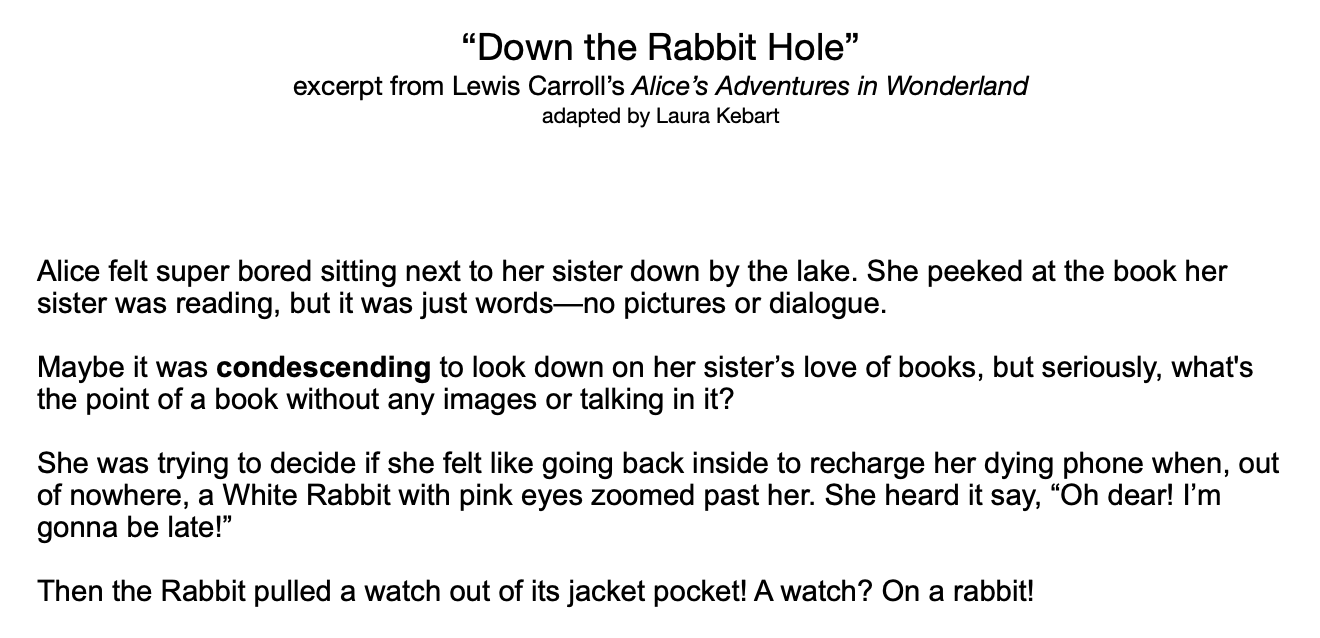
NONFICTION: “School’s Back in Session: Level Up Your Year”
I love to write, and I have so many students in class each year who LOVE gaming (so does my husband, ha!). To grab their interest right away, I wrote a short passage last year from the point-of-view of a “gaming student” who gives advice about how to “level up” your school year using all the typical gaming language… But I kept it low-key as well since not literally every student is a gamer, and I didn’t want to get too carried away by including extra-elusive gaming terminology.
Anyway! Here’s a small excerpt of my literary nonfiction passage which aligns with the “fresh start – fitting in” vibe I was going for:
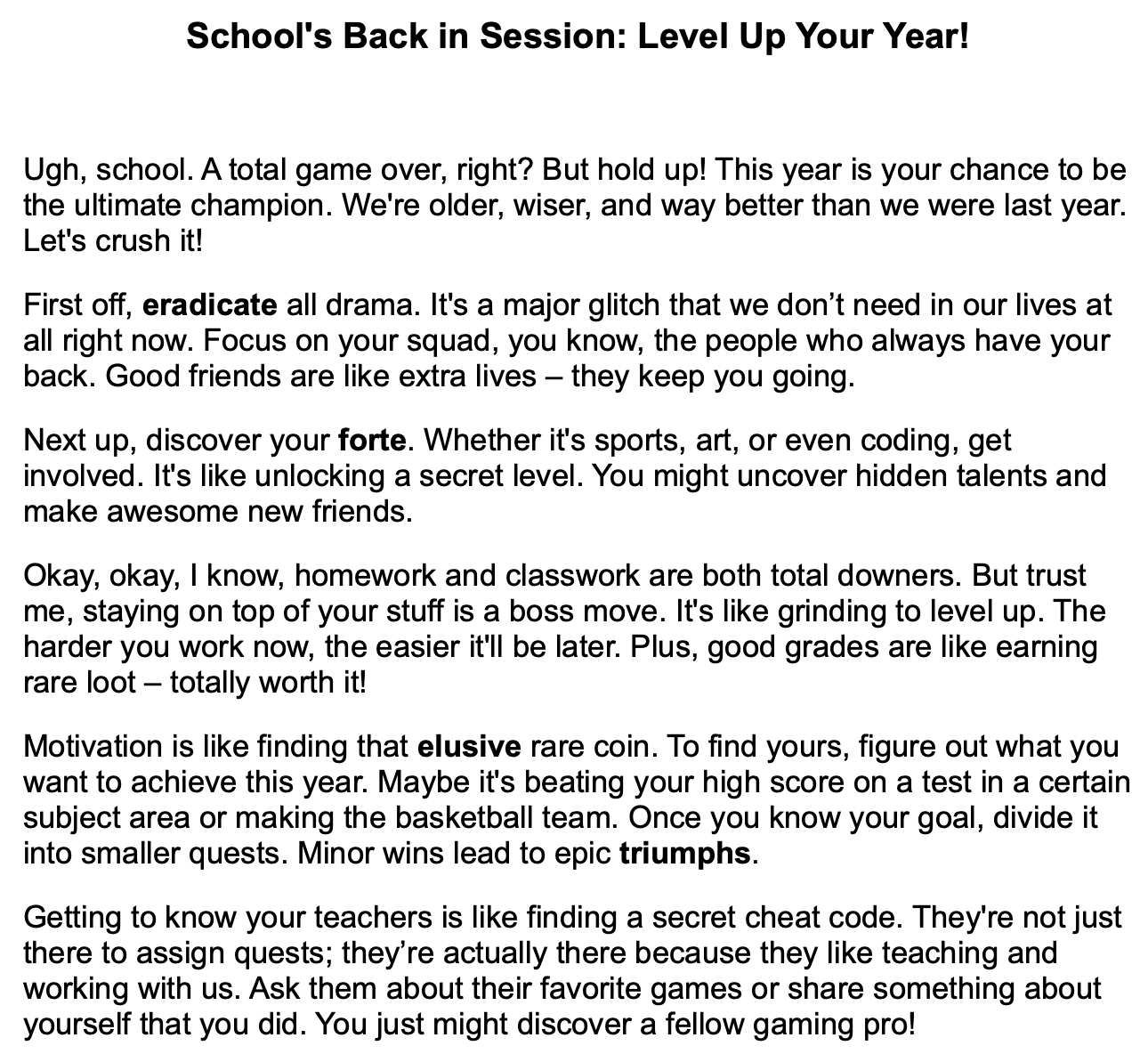
For the rest of the passage AND for all the reading, writing, vocabulary, and grammar station activities that go with it, click here and grab the Ready, Set, Stations lessons🚀
POETRY: “I purposely didn’t title the poem”
I love to write as I mentioned before, and I couldn’t find just the right kind of poem to complete the collection—something thematically linked to fresh starts and new beginnings that was also simple and accessible for struggling students while providing something more substantial for students hungry for discussion.
So once again, I wrote what I needed—what I couldn’t find.
A small excerpt of my one-page title-less poem:
New kid on the block— a shiny penny,
Dropped into a world I don’t quite get.
A jungle of faces, a maze of names,
Lost in the crowd, tired of change.
Ok, so those are the three reading passages that all focus on the theme of “starting new – fitting in” which is so perfect and timely for the beginning of a new school year.
Each reading passage contains four stations:
A reading station, writing station, vocabulary station, and a grammar station.
*** If you’re thinking, “Wow. Four stations… But I have 30 kids in my class, so that means 7-8 kids per station?” Um, no. That is waaay too much!
What I recommend, and what I do myself, is I have two reading stations, two writing stations, two vocabulary stations, and two grammar stations. That means 8 stations with no more than 4 students in each one. This keeps the groups small and very manageable.
So what exactly ARE the station activities themselves? What happens in each of the four stations?
For lack of time and space, I won’t go into the details of all four stations for all three reading passages (because 4×3=12 and details on 12 stations would make for the longest article everrrrrr). . .
So let’s just go through the four fiction station passage—the “Down the Rabbit Hole” re-write I mentioned earlier:
Based on the FICTION passage, students rotate through four stations:
- The Reading Station – Task Cards
Examples of the 12 task card prompts:
- How does Alice’s boredom at the beginning of the passage contribute to her later adventures?
- How does Alice’s personality change or evolve throughout the passage? Explain your reasoning.
- Compare and contrast Alice’s feelings about her sister’s book with her feelings about the world she enters through the rabbit hole.
Students jot down thoughts (bullet points, lists, not complete sentences or anything formal) as they read through the discussion questions and discuss them. They’re allowed to skip questions, and they can spend more time on some of them and less time on others.
- The Writing Station – The SAME 12 Task Cards as the Reading Station!
Yes, that’s by design: These are the SAME questions as the ones that appear in the Fiction Reading Station—-The exact same questions, and that is intentional.
👉Whether students do the reading or writing station first is irrelevant. The point is that these are solid, rigorous questions that students should spend time with, and seeing them in two of the stations is a GOOD THING.
To use these questions in the WRITING STATION, students will simply choose ONE of the 12 questions and respond in writing.
You determine how much they should write. It might be one paragraph. It might be 3… It depends on your students, your grade level, etc.
Other ideas: Or, maybe you have them choose any THREE of the 12 questions and write three sentences in response to each question. Or, challenge the station as a whole to write 2-3 sentences as a response to each question. If you have a station with 4 students in it, or 5, then they can figure out who is going to answer which question and they can help each other, discussing what to write, while also being responsible for their own questions from the collection.
Pro Tip: Later in the year, when you want students to further develop a piece of writing via vocabulary, or figurative language, or practicing embedding quotes and text evidence, or even practicing writing an introductory paragraph—-whatever it may be—-you can always have students come back to this writing response for practice rather than trying to think of a whole new way for them to practice writing. What they write for this writing station lesson can serve as a jumping off point for future writing practice any time of year.
- The Grammar Station:
- Let’s Go Verb Hunting!
- Yes, the verbs appear in the actual reading excerpt.
- Pay attention to the PAST TENSE VERBS → Action words that show something happened in the past Happy verb hunting!
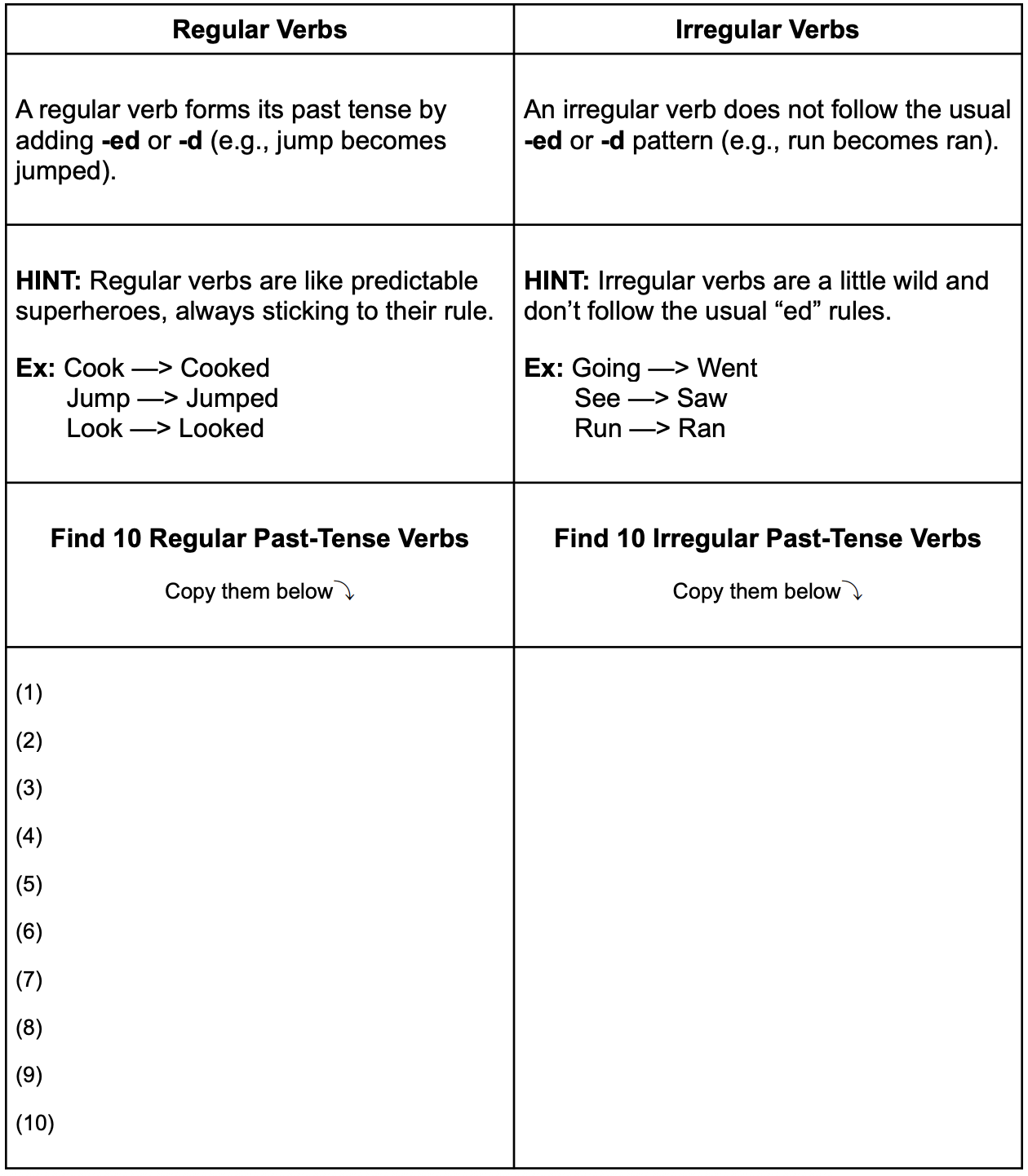
- The Vocabulary Station:
- We’re using a simple fill-in-the-blank practice for this station.
- Words include terms from the reading passage:
- Condescending
- Obsessed
- Daunting
- Reluctant
- Normalcy
Ok, so those are the four stations ALL based on the one reading passage excerpt. I’ve shown just a sample from each station due to time and space constraints here, and I do have teacher ideas and teacher answer keys as well.
As for grading and assessing, I like to do in-the-moment “quick checks” with my students where I can see in real time what they’re working on, what they’re doing, and what they’re understanding or not understanding during station time. If it’s appropriate, I’ll jot down a score that reflects what I’m observing so I know who I need to do some more careful reteaching with vs. who obviously has already mastered the skill and can move on.
Everything I just shared with you is only for one of the three reading passages—the fiction station.
I also run stations just like those (reading, writing, grammar, vocabulary) for the nonfiction passage AND for the poetry passage. Do the math, and that’s a total of 12 stations that I can run throughout the month, all connected to the related theme of “fresh starts – fitting in” so that nothing feels random.
Where I teach, our school year begins in August, but if you don’t start until September, that’s fine—these stations are all about “fitting in” so you’re good to go no matter where the beginning of the school year places you.

